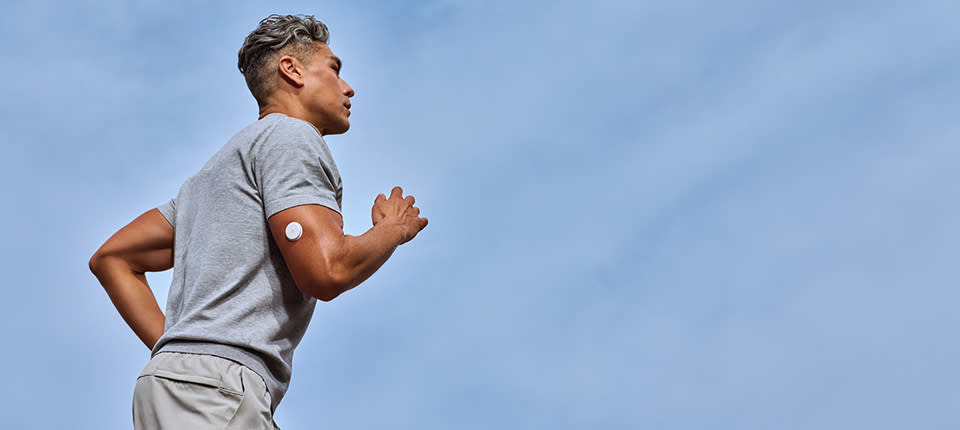Biowearables 101: Health Tech That Goes Deeper
New health wearables give you more options to continuously monitor your glucose levels and understand your body.
NORTHAMPTON, MA / ACCESSWIRE / June 12, 2024 / More and more people, whether they're weekend warriors or people living with diabetes, are coming to understand the impact that glucose has on their mood, sleep and health.
This growing movement is thanks in part to a relatively tiny piece of tech called a biowearable.
What is a Biowearable?
You might be familiar with health wearables in the form of watches or rings, but our biowearables go deeper, literally connecting with your body to deliver real-time insights right to your smartphone.
The insights come from the biowearable's sensor, which measures your glucose level and relays that data every minute. Knowing where you stand helps you make healthy choices in the moment - choices that can help improve your energy, lose weight or manage your diabetes.
Athletes can draw on this information, too. Elite marathoner Eliud Kipchoge is a prime example. He was wearing an Abbott biowearable in 2022 when he finished the Berlin Marathon in 2:01:09, a world record at the time.
Pretty great, right?
The rise of biowearables started in the medical space with our FreeStyle Libre technology for people with diabetes, which is now used by about 6 million people worldwide.1 Studies of the FreeStyle Libre portfolio continue to show positive health outcomes from continuous glucose monitoring.
Now, with FDA clearance of our new Lingo biowearable designed for general consumers interested in improving their overall health and wellness, and our Libre Rio biowearable designed for people with Type 2 diabetes who do not use insulin, there are even more ways to access this life-changing technology.
How Do Biowearables Work?
Biowearables have two main components:
The biosensor that measures data. A tiny, flexible filament (the width of three human hairs) on the back of the biosensor is inserted painlessly below the skin's surface and collects information from interstitial fluid found in the space between cells.
A smartphone app that receives that data and turns it into information you can act on. For example, it might alert you to a dangerously low glucose level or let you know where your glucose level is trending toward so you can be proactive about it.
Which Biowearable is Right for Me?
Lingo is designed for general consumers who are looking to improve their overall health and wellness.
Libre Rio is designed for adults with Type 2 diabetes who do not use insulin and typically manage their diabetes through lifestyle changes. Like Lingo, it is being made available over the counter.
FreeStyle Libre is our world-leading continuous glucose monitor2 for people living with diabetes.
In the future, we could see biowearables with even more offerings. Glucose is just one of several important biomarkers that play a role in health and wellness. Don't be surprised if you eventually see biowearables that can measure and interpret your body's levels of ketones, lactate and more.
The future of biowearables is growing, and it's every bit as bright and diverse as the people who can live healthier because of them.
References
1 Data on file. Abbott Diabetes Care.
2 Data on file. Abbott Diabetes Care. Data based on the number of patients assigned to each manufacturer.
This story was updated on June 10, 2024.
IMPORTANT SAFETY INFORMATION
For Important Safety Information, please visit https://www.freestyle.abbott/us-en/safety-information.html.
About Libre Rio:
Libre Rio is an over-the-counter integrated continuous glucose monitoring (iCGM) device indicated for non-insulin using persons ages 18 and older. Failure to use Libre Rio as instructed in labeling may result in missing a severe low or high glucose event. If readings do not match symptoms or expectations, use a fingerstick value from a blood glucose meter for treatment decisions.
About Lingo:
The Lingo Glucose System is intended for users 18 years and older not on insulin. It is not intended for diagnosis of diseases, including diabetes.
The Lingo program does not guarantee that everyone will achieve the same results as individual responses may vary. Consult your healthcare professional before making changes to your diet or exercise regimen or if you have an eating disorder or a history of eating disorders.

View additional multimedia and more ESG storytelling from Abbott on 3blmedia.com.
Contact Info:
Spokesperson: Abbott
Website: https://www.3blmedia.com/profiles/abbott
Email: info@3blmedia.com
SOURCE: Abbott
View the original press release on accesswire.com

 Yahoo Finance
Yahoo Finance 